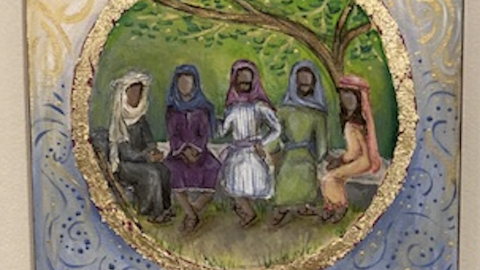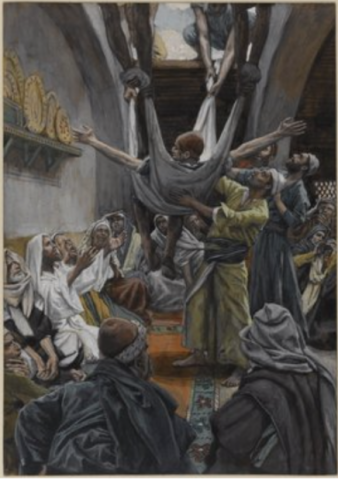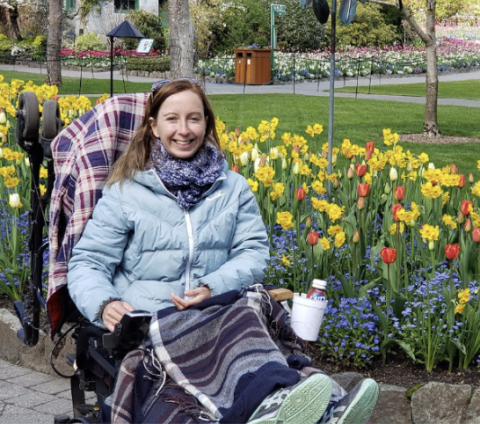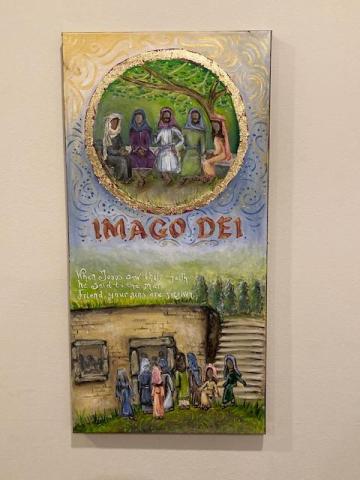Disability Concerns, Biblical Justice
Recognizing the Image of God in Every Body, Story 3: Jesus Forgives and Heals a Paralyzed Man
June 19, 2024
0 comments
75 views

This is one of four stories of disability within the Bible that have historically been portrayed in a way that diminishes the disability story–and the value of seeing God’s image within that person. However, a closer look reveals that the story is less about offering a cure to a person with a disability and more about healing relationships and restoring a sense of community and well-being. Let’s reimagine through art a new way of visualizing these stories.
To access the main article exploring Imago Dei (“image of God”) that presents an in-depth look at how we have perpetuated negative stereotypes through Biblical narrative, please look here: Recognizing the Image of God in Every Body. The rest of the series is accessible in the following posts: Story 1, Story 2, Story 4.
A Retelling of the Story: Jesus Forgives and Heals a Paralyzed Man
In a sense, this passage is about a homecoming for Jesus. He is returning to Capernaum, the home he has chosen for himself after growing up in Nazareth: the central hub of his ministry rests in this fishing village. He has been performing many miracles, and his fame is growing. People are always found gathering around him as he moves through his days.
On this particular day, he can be found at a friend's house, surrounded by Pharisees and scribes. Luke notes they had “come from every village of Galilee and from Judea and Jerusalem.” Concern was growing regarding Jesus’ ministry; the Pharisees and scribes strictly observed and studied the law and scripture, and Jesus had been challenging them. Word traveled through the village about Jesus' presence, and people came flocking to the house to see him – likely in the hopes of seeing another miracle performed, as he had done many of late.
This healing narrative focuses on the faith of a small group of friends who came to the house to ask for physical healing for their paralyzed friend. Unable to get close to Jesus from the first floor, they chose an alternate route – heading up to the roof and making a hole in it to lower their friend into the packed room.
Contrary to the healing narrative of the man born blind who received sight before the gift of eternal life, in this narrative, Jesus forgave the man’s sins before healing his physical body. It was only after the Pharisees and scribes questioned him, thinking that he was speaking blasphemy, that he then chose to physically heal the man as well. Instantly healed, the formerly paralyzed man stood up, rolled up the mat he had been lowered down on, and walked out of the house, singing praises to God.
Perspective from Jenna C. Hoff
I will tell you – I found being pushed in a wheelchair to be a vulnerable and humbling experience. Do you want to go left, stop looking at something, or go around a bump? Better hope the person pushing you agrees! You are at that person's decision-making mercy. That's one reason I was so happy to get a power chair – it returned to me decision-making autonomy over where I go (to an extent). But, it makes me wonder how much more vulnerable the man felt being carried to a roof and lowered through the ceiling.
And it also makes me wonder many things that the story doesn't tell us: For example, was it the man's choice, or was it his overzealous, ableist friends, I wonder, who compelled this roof-lowering escapade?
Did the man want to see Jesus, or was it his non-disabled friends bringing him along without consulting him, as often happens for people who live with disabilities? Did he want to be physically healed? Did he mostly want his sins forgiven, first and foremost? Or was this all driven by his friends, and being paralyzed, he had no ability to physically resist?
How did he feel being unceremoniously dumped at Jesus' feet in front of the crowd? Was he overcome with joy to be forgiven? Was he delighted to be healed? Was he an introvert who despised being the center of attention? Did he feel used, like an object lesson for the teachers of the law? The parallel story of this in Luke 5 mentions he went away thankful, but at what point did that thanks begin?
And, how did Jesus feel seeing the man? Was he sad he had a disability? Seems like his focus was first and foremost on forgiveness, not healing. I assume he felt great compassion and love. I wish the Bible told us more about this story.
Re-visioning the story
Once again, this healing narrative has the capacity to link healing with a negative subtext. In Luke 5:24, the link is clear: ”But that you may know that the Son of Man has authority on earth to forgive sins, I tell you, get up, take your mat and go home.” Jesus links the healing of sin to healing paralysis.
So, what portion of the story can we celebrate that does not perpetuate a harmful narrative? Again, community becomes the focus of the narrative. Could we consider the unwritten narrative of a group of friends sitting together, discussing the miracles of Jesus that they had seen and feeling led to believe in God?
We have assumed that the men came to Jesus to see if he could heal their friend physically, but is that the wrong conclusion? Were they simply trying to hear the word of God and propelling down from the rafters to get a front-row seat for their friend actually made the most sense? If Jesus knew what is in the hearts and minds of man, as we saw in Luke 5:22 when he reprimanded the Pharisees and the scholars, could we not then assume the same of the man who was paralyzed when Jesus offered him forgiveness of sins? Is it that we read the Bible from an ableist lens where we assume the healing that the man had come for was to walk versus being saved? The man had built his own community; we see that from the dedication of his friends to be sure that he was included in the large gathering. Did he already have the support he needed to thrive in Capernaum?
When re-visioning this story, the focus falls on a small group of believers coming together to support and encourage one another in the way of Jesus. Christianity grew and multiplied in those early years through small groups and gatherings of believers. How beautiful to see an example of a small band of friends coming together to share in the joy of believing Jesus Christ had come to give them eternal life.



Disability Concerns, Church Admin & Finance
Disability Concerns, Church Admin & Finance
Disability Concerns, Training and Education
Disability Concerns
Connect to The Network and add your own question, blog, resource, or job.
Add Your Post
Let's Discuss
We love your comments! Thank you for helping us uphold the Community Guidelines to make this an encouraging and respectful community for everyone.